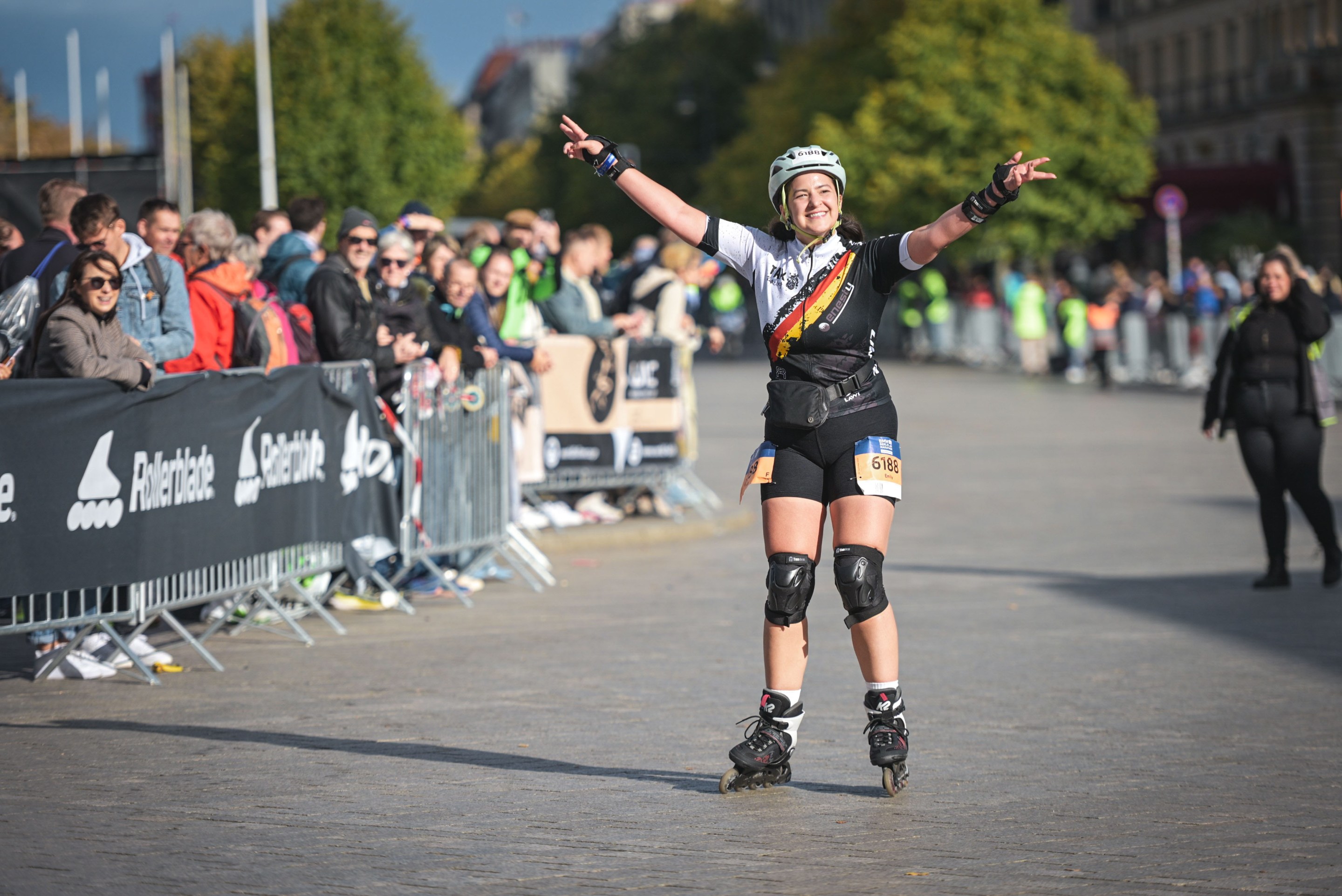BERLIN — My toenail ripped five miles ago and the pain is overwhelming. The looming dark skies make good on their threat as rain begins to sprinkle. The wind picks up. My heart quickens. I am in the middle of every rollerblader’s nightmare. All around, skaters skid and slow for fear of falling or colliding.
A few feet ahead of me, a far-too chipper man in a white helmet races up to a woman as she cautiously makes her way down the road, her legs shaking harder with every glide.
“You appear to be very terrified!” he gleefully points out. She shoots a look at him, disbelief and disgust in her eyes.
“Yeah?” She moves through the drizzle, a vision in black lycra and a gray water backpack. “That’s because I am.”
I head down the slick street towards the fork in the road marked by orange arrows painted on the pavement. To the left, an indication of the race’s loops—skaters must complete five seven-kilometer laps around the course to achieve marathon distance—and to the right, a single word: “Finish.” I curse as my body veers left to embark on loop number three … four … five? Whatever it is, I realize there’s much more to go. One aching foot in front of the other, I push on.
The Berlin Inline Skating Marathon, started in 1997, is the world’s largest, drawing more than 5,000 participants annually. I first learned of it in Spring 2023, when my childhood best friend, Elizabeth Hentschel, announced to our tight-knit group that she’d be participating in the race that fall. No one doubted she could finish; Elizabeth is a force of nature who can do just about anything once she sets her mind to it. What we did question, however, was why.
A few weeks before Elizabeth signed up, her friend Molly Pomeroy received disappointing news: She didn’t win the lottery for entry into the running race. An avid marathoner, Molly plans to complete the World Marathon Majors (a global championship comprising races in Tokyo, Boston, Berlin, London, New York, and Chicago), and not getting into Berlin had been a setback. But Molly found a loophole: the “Skate to Run” program.
The initiative is a means of bridging the gap between the running and blading events. Successful finishers of the Berlin Inline Skating Marathon (within the time constraints) receive guaranteed entry into the following year’s marathon. Makes sense, right? Anyone willing to put their body through 26.2 miles of rollerblading should have the opportunity to test it further by running the same distance.
Molly and Elizabeth signed up, and in September 2023, my friends and I cheered from the States as both girls skated across the finish line in under 2:30, that year’s time limit for the race.
I’m not sure whose idea it was, but once Elizabeth and Molly announced they’d be returning to Berlin in 2024 to run the marathon, my friends and I decided we’d join—as rollerbladers. There were five of us: Lexi Wehbe, an internal medicine resident and generally coordinated athlete; Shannon Manz, also an internal medicine resident and a former competitive figure skater; Sara Pawloski, a patient specialist manager and Chicago intramural volleyball star; Maddi Gonte, plastic and reconstructive surgery resident and avid rock climber; and me: Emily Bice, a Brooklyn-based writer who once tripped while standing still.
Until about four months ago, I did not know how to rollerblade, so when I registered, many of my friends begged, “Please, Emily, no.” I didn’t listen. I was determined to learn. I was confident I could figure it out.
Three weeks before the marathon, I wasn’t sure I’d even be able to complete a loop, let alone finish. I had resigned myself to ending up on the “Broom Wagon”—a mysterious bus that slow bladers get scooped into if they don’t meet the time limit. None of the experienced skaters I talked to had been on it, and I wasn’t sure if it was a joke or a real threat. But I figured I’d find out soon enough.
The thing about learning to rollerblade as an adult? It is incredibly hard. As a kid, it’s exciting to careen down a path, arms flying as you crash into a trash can. Getting hurt isn’t so scary. Bodies are lower to the ground, and it’s easier to get up after being knocked down.
As a 28-year-old, every fall feels like a personal failure. I felt real fear, and not just of broken bones. It’s the cost of insurance and the hospital stay and “Do I have to take time off of work?” and also the embarrassment, the dejection, the shame of being watched as you stumble and struggle and cannot seem to succeed.
In the summer of ‘24, I flailed through the parks of Brooklyn in a blue helmet, rollerblades, head-to-toe protective gear, and bruised shins. I tried everything to learn—roller dance class, how-to TikToks, deep dives into rollerblading history—but none of it gave me the control or confidence I lacked.
I kept at it. For months, I fought through falls and tried not to compare myself to friends. I reminded myself that tough things take time—but how much? And what happens if you run out of it? By September, I still didn’t have the hang of things. Less than a month from the marathon, I knew I’d have to make a hard call. The last thing I wanted to do was seriously endanger myself or others. At some point you have to quit, and I was there.



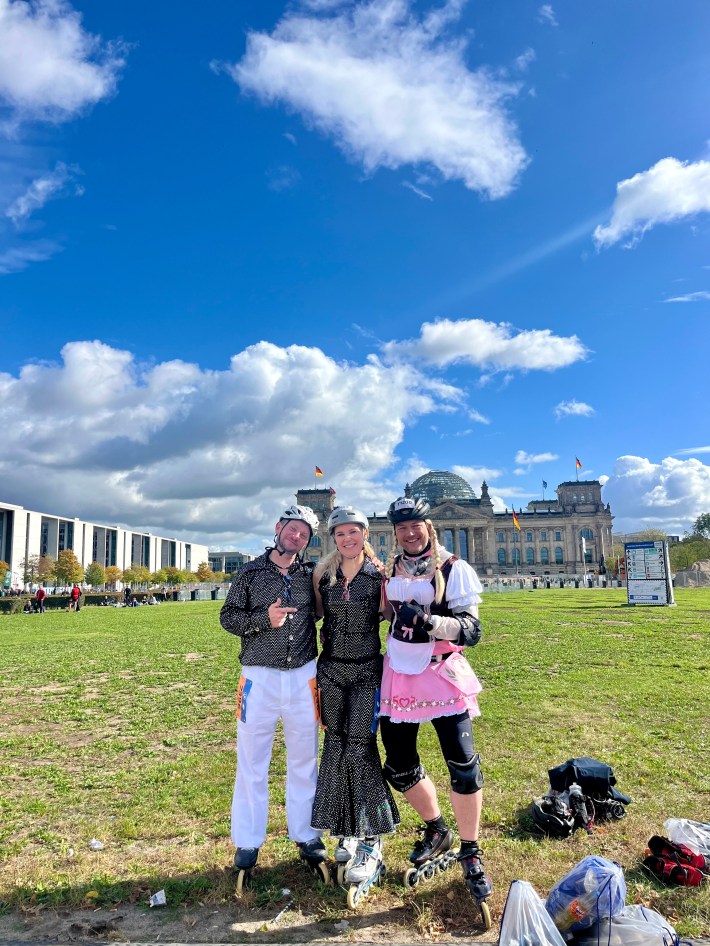
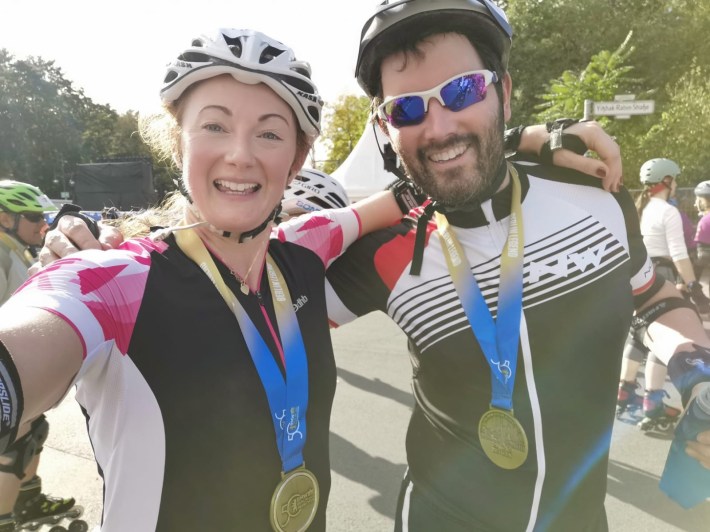
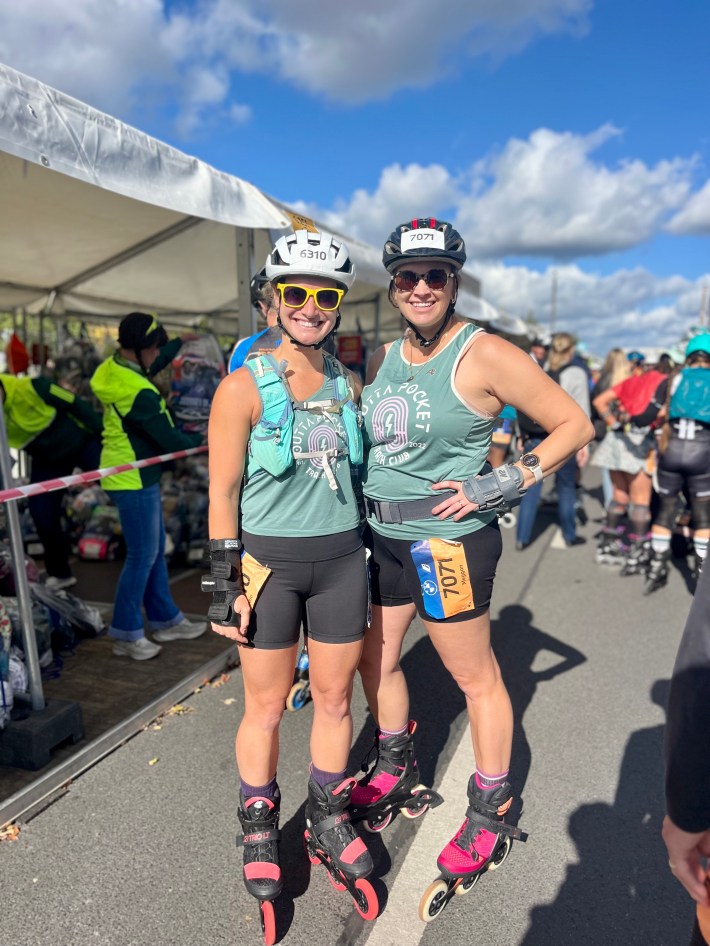
Maybe it was that acceptance that helped me finally find my footing. Whatever it was, one morning, just weeks before the race, I begrudgingly strapped on my blades, started moving, and suddenly … I could skate. Something had clicked. The fear was gone, replaced by freedom. I could do this. I wouldn’t be like the other racers, but that was fine. I could go to Berlin just to give it my all, knowing the chances of completing the race in time were slim to none.
The actual marathon was on Saturday, Sept. 28th, but for me the race began that Thursday, the moment my plane’s wheels touched down in Germany. There were bladers all over Berlin, and anyone with a helmet and a set of skates was a friendly face. In the passport control line I chatted with Tom Janousek, a seasoned skater with an epic beard. He warned of “drafting,” a technique when the lead athlete in a peloton blocks wind for the close-following line behind them.
“If someone grabs your back, they’re not trying to be creepy,” Tom advised. “They’re just trying to slow down!”
Friday at the event expo, held at the now-defunct Berlin Tempelhof Airport, thousands of participants wandered across the open airfield to check in and buy merch. I met Laura Davey, a childhood blader nervous for her first marathon, at the bib pick-up booth. She was doubtful about finishing within the time limit: an intimidating 2:10. Athletes would have 20 minutes less the usual 2:30 from previous years. But stronger than Laura’s trepidation was her desire to compete. “Very few people have rollerbladed a marathon,” she proudly noted. “I wanted to be able to complete it.”
And then it was race day. Prepped but panicked, I guzzled coffee on the S-Bahn over to the marathon meeting point. The start zone was an absolute zoo of rollerbladers. Port-a-potties lined the area, and athletes zoomed around. A man in a hot pink wig passed a group of older women lacing up blades and chatting in Dutch. A flock of purple-jerseyed students from Die Gaesdonck, competing as the culmination of a year-long class, huddled with their teacher. Storing a plastic bag of personals at the check-in tent was Larry Kao, a SoCal dad blading that day and running the following.
As for my squad, we had grown, now including Jim Hentschel, Elizabeth’s father who I’ve known since birth, and Meggan Holcomb and Lydia Brough, gregarious bladers from Tampa who we’d met that morning. Our eclectic group gathered on the grass for a final pre-race stretch. We were ready for it to be over and unsure we wanted it to begin. But we were in this together.
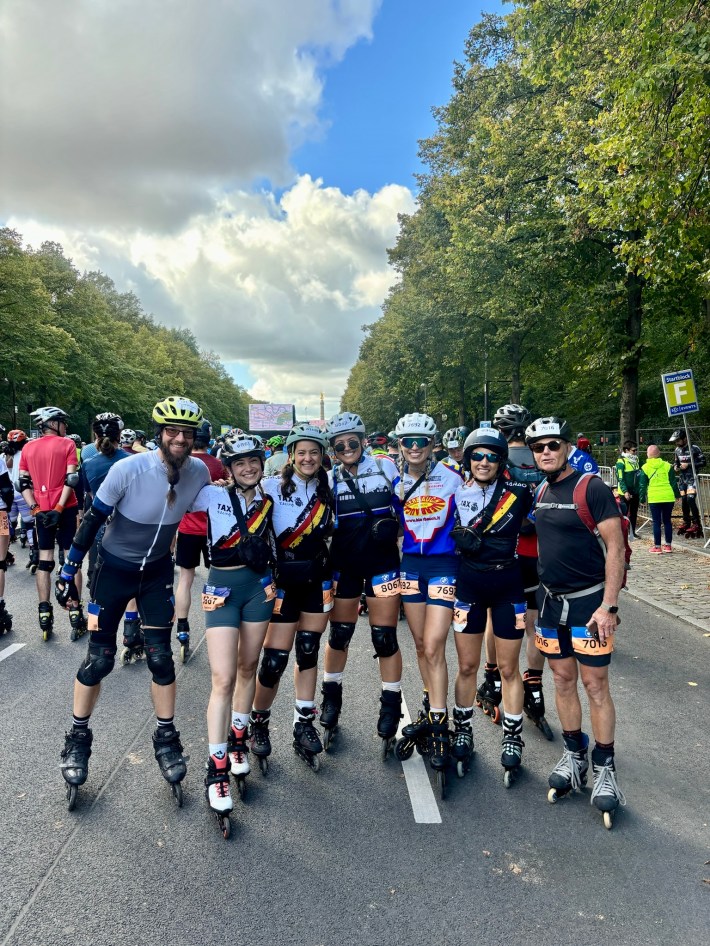
“LET’S GO EMILY!” Maddi whizzes past me as we near what must be (please, God) the end of the race. The pavement is dry again, but my face isn’t. Tears stream down my cheeks—not just from the lost toenail, but from disbelief: I may actually cross the finish line.
My exhausted body receives a miracle: The final loop closes off before I can reach it, and my only option is to turn toward “Finish.” My head shakes in disbelief. I wouldn’t complete the marathon—I estimate my distance at around 20 or 21 miles—but I didn’t care. I was going to finish! I look around: There’s just about every style of architecture along my path, a reminder of Berlin’s tumultuous history and ever-evolving identity. A street sign indicates Checkpoint Charlie is just a few blocks away, and a giant Currywurst resting atop a restaurant causes my mouth to salivate.
Skating through the streets, it dawns on me: I missed the Broom Wagon. I am ecstatic, if not a bit disappointed. It would’ve been cool to meet the riders on the slow bus.
But … Where was the wagon? Was it all a joke? As I ponder whether or not the Berlin Marathon was pulling one over on us, I realize that around me, there aren’t a lot of people. In fact, besides a few skaters ahead, I might be the only one on the road.
Then out of nowhere, two neon-clad Germans on bicycles roll up on either side of me.
“Hello, Emily!” They grin, keeping pace with my blades. “Can you go faster please?”
If I had looked behind the bikers, the giant red bus brimming with slow skaters would have confirmed what I already knew: I had met my makers. This is the Broom Wagon.
Now flanked by my two German cyclists, I go full speed ahead, throwing every last ounce of grit into my skates. The Broom Wagon will not take me now! As the last racer on the course, I am sure that almost everyone else, including my eclectic team of friends, has done it. I can, too. I have worked for this. I am going to finish.
As I make the charge, I’m motivated by Peter Brangstrup, the 19-time inline finisher I’d chatted with shortly before the race began. Wearing a long blonde wig and a Bavarian dirndl, alongside two friends in glittery outfits that put ABBA to shame, they all gave the same answer when I asked why they blade: “It’s fun.”
“Are you afraid at all?” Around us, athletes geared up, gobbling energy chews and chugging final sips of water.
“Why?” Peter looked at me strangely, kind laughter in his eyes. “Why would I be afraid?”
Sweat pours down my brow and my breath hitches as my entourage and I round the corner. Finally—FINALLY—the Brandenburg Gate gleams in the distance. My face hurts from grinning as I race towards the iconic monument.
Erected in 1791 by the King of Prussia, the Brandenburg Gate was one of the few structures left in Pariser Platz after the fall of Berlin in 1945. It stood as a symbol of survival, then separation, when the Berlin Wall was erected along the Western edge of the site. The Berlin Marathon has always passed through the Gate, meaning until the Wall fell in 1989, only West Berliners could partake in the event. But now, in a unified Germany, it is a symbol of peace, freedom, and perseverance.
It is also the place where I eat complete and total shit in front of hundreds of spectators.
Mere meters from the Gate, I’m flying high. I’ve defeated the Broom Wagon. I haven’t fallen. I’m about to reunite with my crew, clink beers and yell “Proost!” In an attempt to finish with gusto, I aim for a little more speed when suddenly—SCREECH!
The world goes into slow motion as my wheels slip out from under me. I’m airborne, arms fluttering, the sky in my sights. Well, this seems about right, I think, seconds before my body slams back to the ground. Ow.
Three medics, two police officers, and my beloved Broom Wagon bikers peer down at me. Behind them, the big red bus has come to a dead stop. Spectators ahead of us look on, shocked. I burst into tears.
A hunky medic offers a hand. I brush dirt off my wrist guard and shakily grab hold. The concern in his eyes tells me all I need to know: It was a bad fall. I stand, wincing with every breath.
“Are you OK?” he asks. Honestly, I’m not sure, but I know this: I am not getting on that bus. I didn’t train for months, endure judgmental glares from children in parks, scrape every inch of my skin, fly to Berlin, rollerblade 20-something miles, potentially lose a toenail, and wipe out mere meters from the Brandenburg Gate just to not cross that finish line. Perhaps this is what I’d been working towards all summer: facing the moment when all is lost and realizing it won’t—it can’t—break you. I am stronger than my worst fall.
“Can I finish?”
The surprise on the medic’s face almost makes me laugh. “If you think you can!”
I blade ahead.
The next five minutes feel like 10 hours. I drag one foot in front of the other, happy-sad tears streaming down my face while my entire body roars in pain. To my right, I hear Elizabeth shouting my name. And then … everyone is. The thing about being the only one left in a race is that you really get to make it about you.
Literally. Gliding over cobblestones under the Brandenburg Gate, I look up at a massive temporary TV screen to see none other than … myself wobbling down the path. Oh, God. Suddenly, still meters from the official finish line, a hulking German man puts his arm around me, shoving a microphone in my face, asking my name and where I’m from. The sun catches my eyes and I squint up at him.
“Um, I’m Emily and I’m from New York.” My voice booms across the plaza.
“And how did the marathon go?” It takes everything in me not to crack up. What does he think? My face is streaked with tears, and my body is caked in dirt.
“Well, I think I lost a toenail.” This does not impress the interviewer or the crowd. I flash the best smile I can and ham it up. “But it was a great way to see the city of Berlin!”
I blade across the finish line and collapse onto the nearest medical stretcher, medal in hand. That’s when I hear it: Sinatra’s “New York, New York” blaring as my German friend shouts on the loudspeaker, “Congrats to Emily from New York, the last person to finish the Berlin Marathon!”
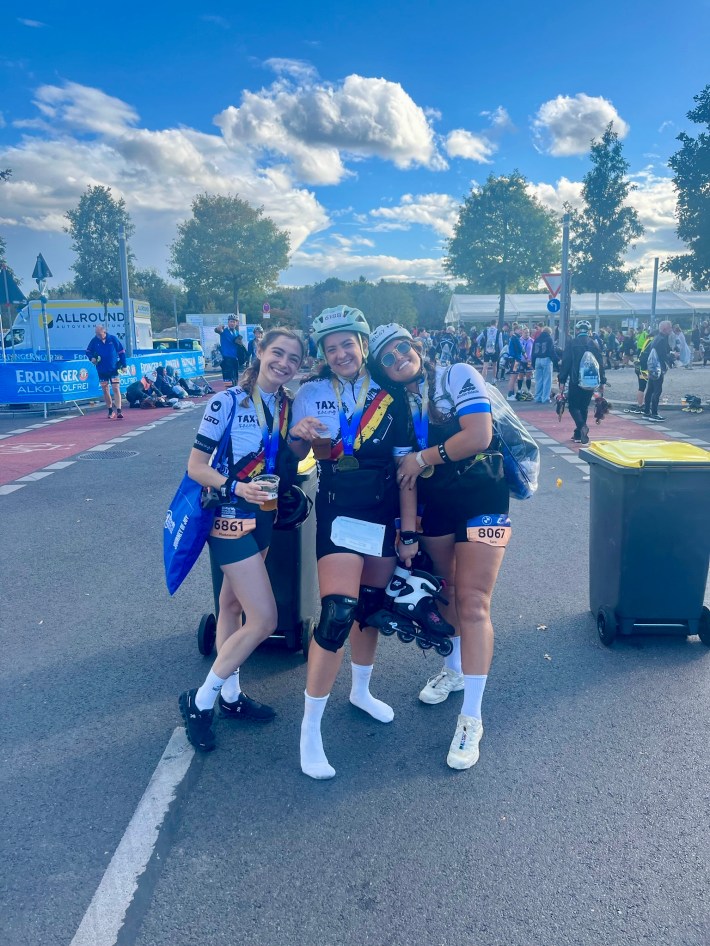
Later that night, I sat around a table at a nearby bar with my exuberant and exhausted friends, running my bruised fingers over the glistening gold medallion. I nursed a beer and a black-and-blue right middle toenail. It hadn’t completely fallen off, after all.
